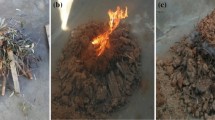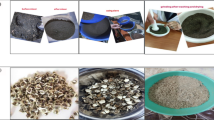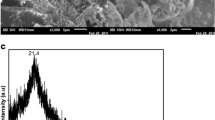Abstract
Several researchers have proved that agricultural by-products constitute good adsorbents for removing heavy metals from aqueous solution. However, few investigations have identified efficient strategies for the adsorbent′s regeneration. Hence, a global methodology for the removal of copper and nickel metals from wastewater including metal biosorption, thermal treatment and residual ash landfill is proposed. In order to validate this strategy, olive solid waste (OSW), provided by an olive oil mill from Tunisia, were used to remove copper and nickel on batch experiments. Copper and nickel were adsorbed on a monolayer of OSW surface with maximal adsorption capacity (q max) of 3.6 and 1.7 mg g−1, respectively. Contaminated OSW with copper and nickel were combusted at 850 °C in an electrical furnace. About 96 % of each metal was recovered in residual ashes that present a good secondary raw material for copper and nickel production. Low leaching transfers (≤4 %) were observed for copper and nickel from residual ashes leading to the possibility to be landfilled. Therefore, the suggested process can be used as an alternative to the classical technologies for effluent decontamination.





Similar content being viewed by others
References
Ang XW, Sethu VS, Andresen JM, Sivakumar M (2013) Copper(II) ion removal from aqueous solutions using biosorption technology: thermodynamic and SEM–EDX studies. Clean Techn Environ Policy 15:401–407
Aravindhan R, Selvamurugan AFM, Rao JR, Balachandran UN (2012) Adsorption, desorption, and kinetic study on Cr(III) removal from aqueous solution using Bacillus subtilis biomass. Clean Techn Environ Policy 14:727–735
Athar M, Farooq U, Ali SZ, Salman M (2013) Insight into the binding of copper(II) by non-toxic biodegradable material (Oryza sativa): effect of modification and interfering ions. Clean Techn Environ Policy. doi:10.1007/s10098-013-0664-9
Ayoob S, Gupta AK, Bhakat PB, Bhat VT (2008) Investigations on the kinetics and mechanisms of sorptive removal of fluoride from water using alumina cement granules. Chem Eng J 140:6–14
Baccar R, Bouzid J, Feki M, Montiel A (2009) Preparation of activated carbon from Tunisian olive-waste cakes and its application for adsorption of heavy metal ions. J Hazar Mat 162:1522–1529
Blazquez G, Martín-Lara MA, Dionisio-Ruiz E, Tenorio G, Calero M (2011) Evaluation and comparison of the biosorption process of copper ions onto olive stone and pine bark. J Indus Eng Chem 17:824–833
Chen YN, Liu CH, Nie JX, Luo XP, Wang DS (2013) Chemical precipitation and biosorption treating landfill leachate to remove ammonium–nitrogen. Clean Techn Environ Policy 15:395–399
Chouchene A, Jeguirim M, Khiari B, Trouvé G, Zagrouba F (2010) Study on the emission mechanism during devolatilization/char oxidation and direct oxidation of olive solid waste in a fixed bed reactor. J Anal Appl Pyrolysis 86:168–174
Council decision of the 19 December 2002 establishing criteria and procedures of waste at landfills
Demirbas E, Kobya M, Senturk E, Ozkan T (2004) Adsorption kinetics for the removal of chromium(VI) from aqueous solutions on the activated carbons prepared from agricultural wastes. Water SA 30:533–540
El-Ashtoukhy Z, Amin ES, Abdelwahab NK (2008) Removal of lead(II) and copper(II) from aqueous solution using pomegranate peel as a new adsorbent. Desalination 223(223):162–173
European Decision 2000/532/CE (2000) Commission decision of 3 May 2000 replacing decision 94/3/EC establishing a list of wastes pursuant to article 1(a) of council directive 75/442/EEC on waste and council decision 94/904/EC establishing a list of hazardous waste pursuant to article 1(4) of council directive 91/689/EEC on hazardous waste
European Standard EN NF EN X31-210 (1992) Déchets—Essais de lixiviation
Fernandez MA, Martinez L, Segarra M, Garcia JC, Espiell F (1992) Behavior of heavy metals in the combustion gases of urban waste incinerators. Environ Sci Technol 26:1040–1047
Fiol N, Villaescusa I, Martinez M, Miralles N, Poch J, Serarols J (2006) Sorption of Pb(II), Ni(II), Cu(II) and Cd(II) from aqueous solution by olive stone waste. Sep Purif Technol 50:132–140
Fujimori E, Shiozawa R, Iwata S, Chiba K, Haraguchi H (2002) Multielement and morphological characterization of industrial waste combustion fly ash as studied by ICP-AES/ICP-MS and SEM–EDS. Bull Chem Soc Jpn 75:1205–1213
Gharaibeh SH, Abu-el-sha’r WY, Al-Kofahi MM (1998) Removal of selected heavy metals from aqueous solutions using processed solid residue of olive mill products. Wat Resea 32:498–502
Hawari A, Rawajfih Z, Nsour N (2009) Equilibrium and thermodynamic analysis of zinc ions adsorption by olive oil mill solid residues. J Hazard Mat 168:1284–1289
Ho YS, Chiu WT, Hsu CS, Huang CT (2004) Sorption of lead ions from aqueous solution using tree fern as a sorbent. Hydrometallurgy 73:55–61
Hodaifa G, Ochando-Pulido JM, Driss Alami SB, Rodriguez-Vives S, Martinez-Ferez A (2013) Kinetic and thermodynamic parameters of iron adsorption onto olive stones. Ind Crops Prod 49:526–534
Kardam A, Raj KR, Srivastava S, Srivastava MM (2013) Nanocellulose fibers for biosorption of cadmium, nickel, and lead ions from aqueous solution. Clean Techn Environ Policy. doi:10.1007/s10098-013-0634-2
Karlfeldt K, Steenari BM (2007) Assessment of metal mobility in MSW combustion ashes using water as the reagent. Fuel 86:1983–1993
Khan NA, Ibrahim S, Subramaniam P (2004) Elimination of heavy metals from wastewater using agricultural wastes as adsorbents. Malays J Sci 23:43–51
Klein DH, Andren AW, Carter JA (1975) Pathways of thirty-seven trace elements through coal-fired power plant. Environ Sci Technol 9:973–979
Laitinen A (2007) Electrostatic precipitators in small scale wood combustion. In: Hytönen K, Jokiniemi J (eds) Reduction of fine particle emissions from residential wood combustion workshop in Kuopio on May 22–23, 2007. University of Kuopio, Kuopio
Nuhoglu Y, Malkoc E (2009) Thermodynamic and kinetic studies for environmentaly friendly Ni(II) biosorption using waste pomace of olive oil factory. Bioresour Technol 100:2375–2380
Ohlstrom M, Makkonen P (2007) Technologies for controlling fine particle emissions. In: Hytönen K, Jokiniemi J (eds) Reduction of fine particle emissions from residential wood combustion, Workshop in Kuopio on May 22–23, 2007. University of Kuopio, Kuopio
Pagnanelli F, Toro L, Veglio F (2002) Olive mill solid residues as heavy metal sorbentmaterial: a preliminary study. Waste Manag 22:901–907
Reddy BR, Mirghaffari N, Gaballah I (1997) Removal and recycling of copper from aqueous solutions using treated Indian barks. Resour Conser Recycl 21:227–245
Saviozzi A, Riffaldi R, Levi-Minzi R, Scagnozzi A, Vanni G (1993) Decomposition of vegetation-water sludge in soil. Bioresour Technol 44:223–228
Serpaud B, Al-Shukry R, Casteignau M, Matejka G (1994) Heavy metal adsorption (Cu, Zn, Cd and Pb), by superficial stream sediments: effects of pH, temperature and sediment composition. Revue des Sciences de l’Eau 7:343–365
Tiwari DP, Singh DK, Saksena DN (1995) Hg(II) adsorption from aqueous solutions using rice-husk ash. J Environ Eng 121:479–481
Trouvé G, Kauffmann A, Delfosse L (1998) Comparative thermodynamic and experimental study of some heavy metals behavior during automotive shredder residues incineration. Waste Manag 18:301–307
Veglio F, Beolchini F (1997) Removal of metals by biosorption: a review. Hydrometallurgy 44:301–316
Wu CY, Biswas P (1993) An equilibrium analysis to determine the speciation of metals in an incinerator. Combust Flame 93:31–40
Xie R, Wang H, Chen Y, Jiang W (2013) Walnut shell-based activated carbon with excellent copper (II) adsorption and lower chromium (VI) removal prepared by acid–base modification. Environ Progr Sust Energy 32:688–696
Author information
Authors and Affiliations
Corresponding author
Rights and permissions
About this article
Cite this article
Chouchene, A., Jeguirim, M. & Trouvé, G. Biosorption performance, combustion behavior, and leaching characteristics of olive solid waste during the removal of copper and nickel from aqueous solutions. Clean Techn Environ Policy 16, 979–986 (2014). https://doi.org/10.1007/s10098-013-0680-9
Received:
Accepted:
Published:
Issue Date:
DOI: https://doi.org/10.1007/s10098-013-0680-9




